- top rated
The XILS 4 emulates a prototype that was never released, the EMS VCS4, based on two integrated, interlinked and interacting VCS 3 ( Synthi) cores. We also coupled them with the famous 256 analog polysequencer.
Like the 2nd huge Pin Matrix, and its numerous additional modules:
- Envelopes, LFOs, S&H, Voltage Processor, Pitch Tracker, Transient etc.
- Or the recreation of the unique, powerful 256 analog Polysequencer, intimately tied to the synthesis engines.
- Add to that the analog Chorus ( 3 modes ) Delay and Phaser, the Spring Reverb, and the picture emerges.
In the XILS 4, you can connect everything with everything, and you get more than 1140 possible different connexions per patch. Did we say at Audio Rate?
An endless source of inspiration for those who want to go deep into the heart of Analog Modular Synthesis.
It’s impossible to summarize what the XILS 4 can do, but, in short, here’s the list of the main modules:
- 12 Aliasing free Oscillators, grouped in 6 pairs, with WaveShaping, 3*2 Hard synchronization modes, + 2 additional Noise oscillators
- 2 Analog Multimode Filters, Non Linear and zero delay Behaviors, with 3 Modes (12/18/24 dB)
- 4 Trapezoidal, looping, Envelope Generators. ( Switchable to standard ADSR )
- 5 Polyphonic LFOs ( including 4 Oscillator acting as LFO at audio rate )
- Polyphonic Ring Modulator and VCA engine
- Cascade Mode: Synthesizer 1 can feed Synth 2 engine inputs
- 4 independent outputs feeding the Stereo Bus, each with one analog Lp/Hp filter
- 2 Programmable Joystick Vector Controllers ( up to 32+32 modulation targets )
- Polyphonic Sequencer with 3 independent lines, Slew rates, 3 recording modes.
- Sequencer can behave as modulation source.
- Pitch Tracker, Enveloppe Follower, Transient, Gate, Sample & Hold Modules
- Chorus, Delay, Phaser, Spring Reverb
- 6 Play modes (including Unison 2/4/6 ), Polyphonic and mono Portamento/Glissando/Legato, 2 different Keyboard Scaling, Polyphonic Aftertouch and VCA handling.
- Nearly 700 presets made by worldwide famous Sound Designers
- Preset Database Engine ( Find the right patch in a flash, create your own tags )
- Comprehensive manual with a getting started and tutorial sections
- More than 100 parameters mappable to midi controllers
- More than 1100 possible connexions per patch!!!
With the XILS 4 research Synthesizer, things that were impossible yesterday become now possible, with never ending programming possibilities.
Not sure you’re ready for modular monsters ? This synthesizer includes a new preset factory library, with more than 350 presets that were especially designed for it, and also includes the XILS 3 factory library.
It also includes tutorial patches, helping you to climb the first steps of your modular life.
History: Why two synthesizers for the XILS 4?
Tim Blake told us about his old "Crystal Machine" combo: two linked AKS machines with hard sychronisation between oscillators. One was connected to the keyboard, and the other connected to the sequencer. And Peter Zinoviev also told us about a never released EMS prototype, the VCS 4: two linked VCS3! We mixed both concepts, then added a lot of modules inherited from the XILS 3 and XILS 4 were born !
XILS 4 combines Two XILS 3 synthesizers, that interact in many ways. To understand the genesis of the XILS 3, a recreation of the famous EMS synthi synthesizer, we have to go back to 1969.
1969: The PIN MATRIX REVOLUTION (No More Cables Anywhere)
In a modular synthesizer, you can connect any module to another one. Peter Zinovieff, the visionary synth Wizard, established with the EMS series a new way to connect modules: The Pin Matrix. Just plug a pin in the Matrix, and the connection is set.
Advantages of these techniques were obvious, breathtaking: More inputs and outputs for each module. No more cables cluttering the synth panel. Easy to operate, easy to read, visualize, and build, your patch. No more roadies: The analog modular synthesizer suddenly became portable. Add to this the first Vector Synthesis experiments.
The XILS 3-4 series offers the same advantages and even brings a lot more on the table. Let’s now see the different modules
No synthesis can be done without a good filter: the XILS 4 offers two multimode filters that were modeled to reproduce the analog character of the old machine.
The 18 and 24 db low-pass types can self-oscillate, and internal non linearities have been finely reproduced: It is faithful to the "zero-delay" behavior of real life to give you a big smile when sweeping it.
The PIN MATRIXES: As we saw, modules have to be connected through patch areas called Pin Matrixes.
The XILS 4 offers no less than 8 Pin Matrixes: 2* 256+256 points dedicated to the main audio synthesis, one for the trig connections and 4 for the sequencer connections (one for the modulation and one for the trig connections). Experts will spot at once that, in the 2 extended Matrixes, you can freely define some sources and destinations in the last two rows of lines and columns, like S&H, or even Envelope Segments.
And, yes, that means even more fun, and ultimate tweaking possibilities!
Matrix Synthesizer
The core of the synthesis is based on the original audio modules:
- Six oscillators grouped in Three pairs
- Hard synchronisation
- One Low pass filter with 12, 18 and 24 db slope
- One spring reverb
- One Trapezoidal looping envelop
- One Polyphonic Ring Modulator
- One Noise generator
- Two output static filters
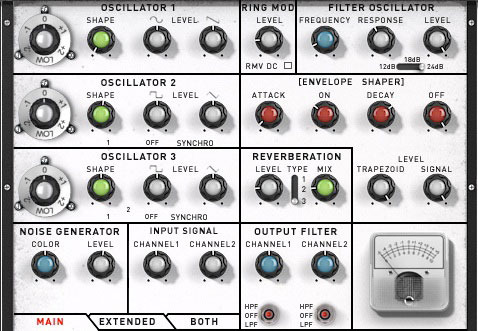
Oscillators : Beyond the digital limitation, in a true analog emulation, as in all XILS-lab instruments, the freedom of the sound which one has in mind when listening to hardware analog synthesizers, the analog spirit have been preserved.
XILS 4 oscillators were modeled to reproduce as close as possible the original waveforms.
The following figures compare the different waveforms of the original AKS model and those of the XILS 4.
As you can see, the raising front is sharp, but as the signal reaches its maximum, it becomes slower. This gives XILS 4 Oscillators an unique analog sound and character : soft and warm, yet very rich in harmonics.
No synthesis can be done without a good filter: the XILS 4 multimode filter was modeled to reproduce the analog character of the old machine.
The 18 and 24 db low-pass types can self-oscillate, and internal non linearities have been finely reproduced : It is faithful to the "zero-delay" behavior of real life to give you a big smile when sweeping it.
The PIN MATRIXES: As we saw, modules have to be connected through patch areas called Pin Matrixes.
The XILS 4 offers no less than 8 Pin Matrixes: Two 256+225 points dedicated to the main audio synthesis, one for the trig connections, and three other for the sequencer connections (two for the modulation and one for the trig connections) Experts will spot at once that, in the extended Matrix, you can freely define some sources and destinations in the last two rows of lines and columns, like S&H, or even Envelope Segments.
Thanks to these added matrix, the sequencer can modulate independently the "right" or the "left" core !
Last but not least, the Keyboard trig can be delayed : the envelopes can be trigged at two different time.
Built Layers, Mix and Match different patches in a flash : Each of the Left & Right synth engines has its own patch browser, in addition to the general patch browser. So that you can load in any of the two synth engines (Left & Right), any L/R part of any patch present in your preset library.
It has never been so easy to layer two leads, or a Pad and an Fx. Together with the Vector Synthesis, this means that you can create your own patches in the XILS 4 very easily and quickly, in an intuitive way.
The Extended Modules (Augmented Matrixity)
To increase the sound design possibilities, we have added 5 other modules, intended to be connected via the Extended Matrix (2x225 new possible connections)
- Two additional envelopes (Trapezoidal or ADSR)
- One Tempo syncable LFO
- One Tempo syncable Sample and Hold
- One voltage processor (with a delay feature)
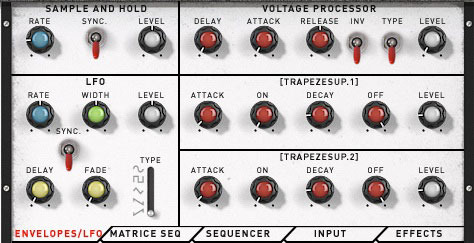
The Polyphonic Sequencer
The Sequencer has been inspired by the EMS 256 sequencer, a 3 layers/2 tracks powerful device with some unique features, like 3 independent slew rate knobs.
Here again a few things were added, like Sequencer Lines acting as Modulations Sources in a special Matrix. Interactions that you cannot reproduce in even the most sophisticated DAW.
Note: The sequencer can modulate or trig the both cores independently.
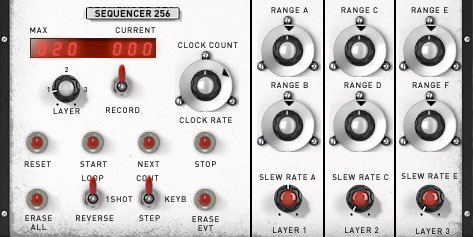
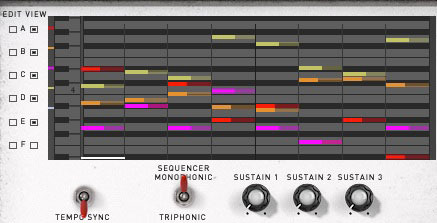
Vector Synthesis
The Pin Matrix and looping analog envelopes weren’t the only innovative features of the EMS series. Vector Synthesis should definitely be added to the list. The Joystick, with its numerous inputs and outputs, should be regarded as a giant step toward Vector Synthesis, and what is now known as Macro controllers.
With the XILS 4 Joystick duo (yes each engine has its own Joystick), you can not only make fascinating real time controlled evolutive sequences or performances, but also find a lot of interested variations patches nested in a single patch. Almost all XILS 4 factory library presets have been created to benefit of the Joystick and other real time controllers.
The Effects
The XILS 4 provides three warm and wick sounding audio effects:
- 3 Modes Chorus
- A Delay (Tempo Syncable)
- A Phaser (with enhanced analog behavior)
Using the XILS 4 as an effect Processor
The XILS 4 can also be used as a terrific effect processor. The plug-in inputs can be used directly, feeding the filters, or as audio rate modulation sources ..... endless possibilities.
To increase a little bit the fun, we added 4 input audio processors, making XILS 4 a fantastic mangling machine!
- Transient Follower (which generates trigs or envelops)
- Envelope Follower
- Featured Gate
- Pitch Tracker
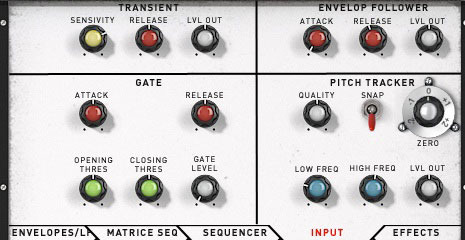
System Requirements
Mac
- Mac OSX 10.3.9 and later : VST, Audio Unit, RTAS (Protools 7.0 and later),AAX (32&64 bits, native)
Windows
- Windows XP, Vista and 7 ; VST, RTAS (Protools 7.0 and later),AAX (32&64 bits, native)
Any references to any brands on this site/page, including reference to brands and instruments, are provided for description purposes only. For example references to instrument brands are provided to describe the sound of the instrument and/or the instrument used in the sample. Plugin Boutique do not have (nor do they claim) any association with or endorsement by these brands. Any goodwill attached to those brands rest with the brand owner. Plugin Boutique or its Suppliers do not accept any liability in relation to the content of the product or the accuracy of the description. "RHODES" is a registered trademark of Joseph A Brandstetter.